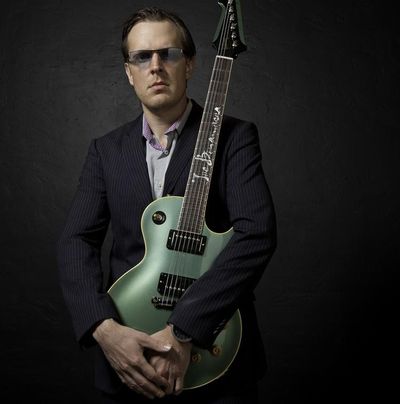From B.B. to Bonamassa: Guitarist brings the spirit of his mentor to his music

Joe Bonamassa started playing guitar before he started school, becoming over the past decade or so arguably the reigning blues-rock six-string king.
But he says it’s unlikely that a kid today will follow in his footsteps, as he did with B.B. King. In the digital age, as many have observed, the electric guitar is an endangered species.
“I tend to agree with that,” Bonamassa said in a recent phone interview. “I’ve been playing guitar professionally, I’ve been playing 29 years. As a musician, I’ve been playing since I was 4, 36 years. It took me seven, eight years to get good enough to play on stage. Kids today can get an iPad and a pair of headphones and be DJing in two weeks.”
A prodigy on guitar who was tutored by guitar legend Danny Gatton, Bonamassa began playing professionally at 11, pulled on stage by B.B. King, who he acknowledges as his mentor.
“How could he not be?” Bonamassa said. “He gave me a stage. He gave me an album. He gave me his friendship. He gave me a guitar. I knew him for 23 years. My desert island record was and still is (King’s) ‘Live at the Regal.’ To me, it’s the epitome of a blues album.”
What Bonamassa didn’t take from King was his guitar style and musical approach
“You’re not going to sound like B.B.,” Bonamassa said. “You’re not going to top ‘Live at the Regal.’ You’re going for the spirit of it. I can cover B.B. King, ‘Live at the Regal’ in its entirety, but I can’t sound like B.B. But I can catch the spirit of it.”
Instead, the young “Smokin” Joe Bonamassa spun the influence of British blues-rock guitar heroes of the ’60s – Eric Clapton, Jimmy Page of Led Zeppelin and Rory Gallagher, with some Stevie Ray Vaughan – into his sound along.
Bonamassa released “A New Day Yesterday,” the first of his 12 studio solo albums in 2000. His most recent studio effort is 2016’s “Blues of Desperation,” which hit No. 12 on the Billboard albums chart. He’s also released three collaborative albums and 15 live records, including this year’s “Live at Carnegie Hall: An Acoustic Evening.” A total of 17 Bonamassa albums have topped the “Billboard” magazine blues chart.
What Bonamassa did take from King is his big band, full of fine players and a classy stage presentation
The band includes: keyboardist Reese Wynans of Stevie Ray Vaughan and Double Trouble fame; drummer Anton Fig, the house drummer for “Late Night with David Letterman”; bassist Michael Rhodes, who has played with the likes of Johnny Cash and Taylor Swift; trumpeter Lee Thornburg, a former member of Tower of Power, and saxophonist Paulie Cerra, who has toured with Stevie Wonder and Bobby “Blue” Bland.
Add in a trio of female backing singers from Australia and a set that looks like a classic theater stage, complete with big band-style podiums in front of the players, and you’ve got the making for the shows that have earned Bonamassa Entertainer of the Year recognition from the Blues Music Awards.
The musical selections for each show vary depending on where the concert takes place.
“I have probably 350 songs to choose from,” Bonamassa said. “We’re doing a little bit of everything. If we’re playing outside, it’s a bit more of a rock show. The outside gigs, you need to hit it a little harder. Inside you have the intimacy and acoustics of the hall and more lighting. You use the room and it doesn’t have to hit as hard.”
That said, Bonamassa insisted there is no guarantee that he or the band will have a good show on any given night – even though the audience might not notice.
“It’s all subject to interpretation,” he said. “It’s all subject to how you’re feeling. If I didn’t tell you I was feeling like crap, you wouldn’t know I was feeling like crap. For the fans, they want to have a good time for the two hours that they get to see it.”
So what happens if Bonamassa doesn’t connect with the audience immediately after coming on stage?
“I have about four, five security guys go rough ’em up,” he said with a laugh. “They start dancing in a hurry. I usually find an old lady or a little kid and send security after them. That gets everybody going.”
Now 40, Bonamassa looks back at his 36 years with a guitar in his hands with satisfaction – and appreciation for the fans who buy his records and who he tries to entertain each time he steps on stage.
“I feel like I’ve accomplished a few things,” he said. “We’ve sold millions of albums. We’ve played thousands of shows. I’m very grateful for where the fans have put me and it is the fans that have put me there.”